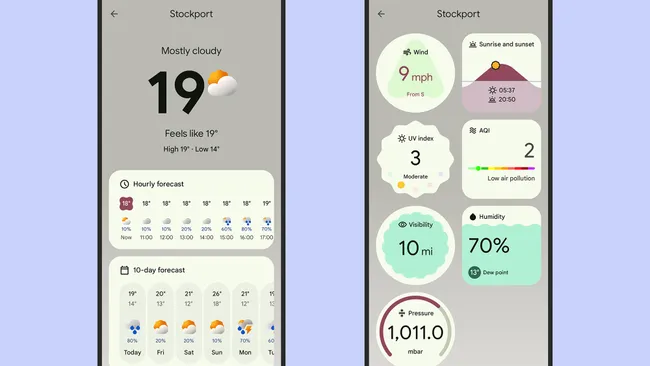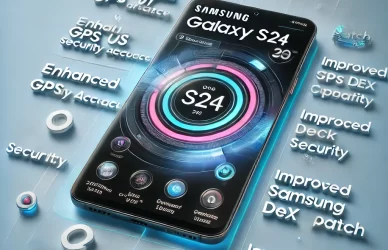Pixel Weather App’s Immersive Vibration Feature: A Game-Changer for User Experience
Google’s Pixel Weather app has introduced an immersive vibration feature that redefines how users interact with weather updates on their smartphones. This innovative update provides tactile feedback tied to real-time weather conditions, making it possible for users to feel the temperature, humidity, and other atmospheric changes. Let’s explore how this feature works, the app’s latest enhancements, and how these upgrades enhance both accessibility and functionality.
Immersive Vibration: A New Level of Weather Engagement
With the immersive vibration feature, the Pixel Weather app aims to bring weather conditions to life in a way that engages multiple senses. This unique functionality uses subtle haptic feedback patterns to represent weather changes. For instance, a gentle vibration might indicate light rain, while more intense pulses could represent a thunderstorm or gusty winds. This feature makes it easier for users to perceive and respond to weather updates without needing to check their screens constantly.
Beyond simply viewing a forecast, this tactile feature helps users physically feel weather alerts. It’s particularly useful for individuals with visual impairments, providing an additional, accessible way to receive weather information. By combining visual, textual, and haptic elements, Google continues to expand the accessibility features of its Pixel devices
Design Enhancements and User Interface Updates
The immersive vibration feature comes as part of a larger Pixel Weather app redesign that has shifted towards a more minimalistic, visually intuitive layout. Google has streamlined the interface to reduce clutter, focusing on displaying essential information like temperature, precipitation, and forecast summaries in large, easy-to-read fonts. The app uses a gradient-based background that changes dynamically based on real-time weather, creating a more visually engaging experience.
New animations within the app further enhance this immersive experience. Animated backgrounds reflect changing weather patterns, such as a sun-kissed gradient for clear skies or a darker, cloudier interface for stormy conditions. These animations complement the haptic feedback, delivering an even richer experience by engaging multiple senses. Users can now “feel” and “see” the weather simultaneously
Real-Time Weather Insights: Enhanced Maps and Notifications
The updated Pixel Weather app offers a detailed view of precipitation patterns through real-time radar maps, showing users current and predicted rainfall zones. Additional data points include wind speed, UV index, visibility, and detailed sunrise and sunset timings, making it a comprehensive weather tool. The radar map’s dynamic color gradients make it easy to track precipitation intensity, with updates rolling out frequently to reflect changing weather conditions
The app’s notifications are another powerful feature, allowing users to receive real-time alerts for conditions like rain or snowfall. This timely information ensures users are aware of impending weather changes, empowering them to make more informed decisions throughout the day.
Pixel 9’s Exclusive AI-Driven Weather Summaries
One of the standout features in the new Weather app is an AI-powered summary generator, exclusive to the Pixel 9 series. Using Google’s Gemini Nano AI processor, the Pixel 9 can create detailed, localized summaries that highlight current conditions and forecasted changes. This personalized approach provides a deeper level of detail than standard weather apps, making it easier for Pixel 9 users to stay prepared for the day’s weather.
The Gemini Nano chip enables more advanced on-device AI processing, generating weather summaries tailored to the user’s location and activity preferences. While this AI-driven feature is limited to the Pixel 9, its introduction could indicate future improvements in AI-driven personalization for upcoming Pixel models
Accessibility and Convenience in Daily Life
The immersive vibration feature aligns with Google’s larger push towards inclusivity and accessibility in its products. By enabling tactile feedback, the Pixel Weather app becomes an excellent tool for users who may have limited access to visual or auditory information. This accessibility-first approach sets a new standard in app design, combining functionality with inclusivity to benefit a broader audience.
The redesign also appeals to users who prefer quick access to essential information without being overwhelmed by excessive details. The app’s widget capabilities allow users to integrate weather updates into their home screens, making it easy to get an instant summary of the day’s forecast.
Should You Upgrade to the Pixel Weather App?
Google’s new immersive vibration feature, paired with its sleek redesign and enhanced functionalities, makes the Pixel Weather app a worthwhile upgrade for Pixel 6 and later devices. For users with the Pixel 9, the added benefits of AI-driven weather summaries take it a step further, offering advanced weather insights that could influence daily planning and preparedness.
This update to the Pixel Weather app represents a significant leap forward in mobile weather applications, blending immersive, sensory experiences with real-time data. As Google continues to refine its app offerings, this update could inspire other tech companies to innovate in accessibility and tactile technology.
Final Thoughts
The Pixel Weather app’s immersive vibration feature is a unique addition that goes beyond traditional weather notifications. By allowing users to feel weather patterns, Google has set a new standard in interactive app experiences, particularly for those with accessibility needs. Whether you’re a weather enthusiast or simply someone who likes to stay prepared, this app upgrade is both practical and engaging, making it an essential tool for Pixel users looking for a modern weather experience.




